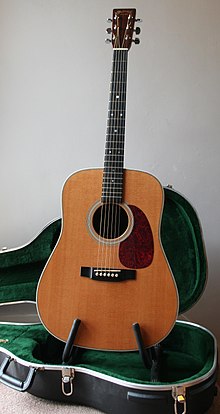Dreadnought (guitar type)
This article needs additional citations for verification. (February 2012) |

The dreadnought is a type of acoustic guitar body developed by American guitar manufacturer C.F. Martin & Company.[1] The style, since copied by other guitar manufacturers, has become the most common for acoustic guitars.
At the time of its creation in 1916 the word dreadnought referred to a large, all big-gun, modern battleship of the type pioneered by HMS Dreadnought in 1906. A body much larger than most other guitars provided the dreadnought with a bolder, perhaps richer, and often louder tone. It is distinguished by its size and square shoulders and bottom. The neck is usually attached to the body at the fourteenth fret.[1][2]
Martin dreadnought guitars are also known as "D-size" guitars. Their model numbers consist of "D-" followed by a number, such as "D-18" and "D-45".[3] The higher the numerical designation, the more decorative ornamentation on the instrument.
History[edit]

The dreadnought style was developed in 1916 by Martin specifically for the retailer Oliver Ditson Company. The model was retired after dismal sales. In 1931, after revising the design, Martin began producing dreadnought guitars under its own brand, the first two models named the D-1 and D-2, with bodies made of mahogany and rosewood respectively; shortly after, these 2 styles were renamed the D-18 and D-28 with "D" indicating body size, and the numbers the timbers used and degree of ornamentation as per other Martin models of the time.[1] Like their Ditson-branded precursors, these 2 models had large bodies, with neck joining the body at the 12th fret, and slotted headstocks holding the tuning mechanisms for the strings. In 1933, owing to a preference from players (especially those transitioning from the banjo) for more frets clear of the body, the body shape was changed to a slightly smaller, squarer shouldered design, which—in conjunction with a slightly adjusted bridge placement—permitted the neck to have 14 frets clear of the body (refer illustration). The "14 fret" design has become the standard for most succeeding instruments manufactured to the "D" body size, although the "12 fret" design has been retained in the Martin line for some special orders, certain 12-string models, and the "-S" designated D-18S, D-28S, D-35S and D-45S, with the "S" suffix, originally just denoting any non-standard custom feature, stabilizing as denoting the 12-fret variant from 1968 onwards. A small run of dreadnought guitars manufactured by Martin for the E.U. Wurlitzer store in Boston designated "SW" for "Special Wurlitzer" in the 1950s-early 1960s also featured the 12-fret design.
The popularity of and demand for Martin dreadnought guitars was increased by their use by folk musicians of the mid-20th century, including most bluegrass guitarists. Dreadnoughts became the standard guitar of bluegrass music,[4] used by many bluegrass musicians to produce a signature sound. While most players prefer the tone of the standard, 14-fret instrument, noted for its more penetrating sound especially when played with other instruments, a few prominent players—including Peter Yarrow of the group Peter, Paul and Mary, Norman Blake, and on occasion Paul Simon (per the cover of his 1974 Live Rhymin' release)—have still favoured the slightly different sonority produced by the 12-fret, larger body shape.
The Gibson Guitar Company's response to the Martin dreadnought was the round-shouldered Jumbo, which it introduced in 1934. It introduced its first square shouldered guitar, the Hummingbird, in 1960.
Since then, dreadnoughts have been made by nearly all major guitar manufacturers worldwide in both standard and single-cutaway forms.
See also[edit]
- Chiterra sarda, a traditional large-bodied guitar from Sardinia
References[edit]
- ^ a b c Ken Achard (1990). History and Development of the American Guitar. The Bold Strummer Ltd. pp. 13–14. ISBN 0-933224-18-4. Retrieved 10 February 2012.
- ^ "Dreadnought Story". Martin Guitar Company. Retrieved 10 February 2012.
- ^ "Martin Standard D45 Dreadnought Acoustic Guitar". Tab Robot.
- ^ "Bluegrass Guitar". Solguitar. Archived from the original on 1 August 2019.
External links[edit]
- What is a dreadnought guitar? on Sixstringsacoustic website
- What is a dreadnought guitar? on Guitarsurfer website
